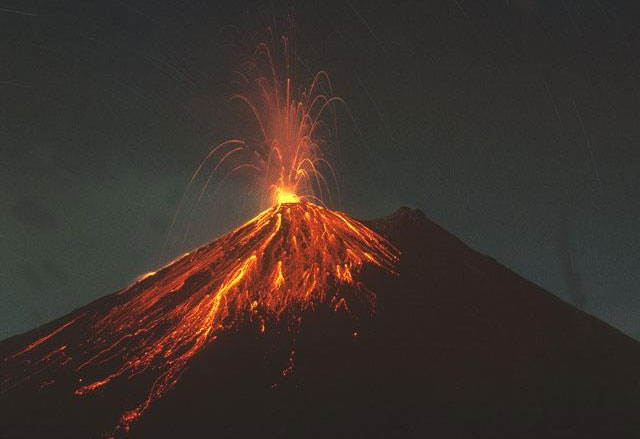Scary volcanoes are more than meteorites
Many people fear the end of the world will come when meteorites crash into our planet. However, super volcanoes are more frightening than meteorites many times.
Until now, people often thought it would take thousands of years to form giant volcanoes, and these volcanoes were "locked" under the earth's crust for thousands of years before affecting. to the planet.
But a new study shows that catastrophic volcanic eruptions, with a much greater degree of devastation than the ghost eruption in Mount St. Helens in 1980, may happen only a few hundred years after the volcano formed.
Compared to such a big event, warming or earth warfare has no meaning, because super volcanoes can fire up in the air tons of dust and obscure sunlight. The consequence will be that the earth has experienced many years of cold temperatures, wiping out millions of plants and animals. A super volcano erupted 250 years ago is believed to be the cause of the largest mass extinction disaster on earth, erasing 95% of all animal and plant species. Some scientists also claim that volcanoes, not meteorites, caused dinosaurs to disappear 65 million years ago.

The threat to the earth may lie right under our feet.
But is it possible that a super volcano will erupt or not? So far no scientist can claim. Super volcanic eruption is the result of the process of accumulating a large lava tank a few miles deep from the ground. So far, no such large lava basin has been formed on the earth and will erupt in the near future.
Scientists have for years thought that when such a large lava tank is formed it will stay in the ground for thousands of years before erupting. But a new study by geologists at Vanderbilt University and the University of Chicago (USA) shows that this process happens much faster, maybe only a few hundred years.
This study is based on the formation of crystals in molten ghosts that decay with a known rate, which in turn can infer many events in volcanic history.
According to the team, scientists previously looked at the decay of zircon, a mineral that is common in volcanic rocks, and concluded that giant magnesia could last about 100,000 years. But the team at Vanderbilt University and the University of Chicago looked at the crystallization process of quartz, the most abundant mineral in volcanic sediments, thus concluding that a giant magma tank only exists in the ground. in time is 1/10 of the previous estimate, and maybe only about 500 years.
This prediction makes the risk of super volcanoes more worrying, but scientists think there is no reason to panic.
The team investigated the sediment in the Long Valley volcanic basin in northeastern California, where the massive eruption occurred, blowing up 150 miles of fused rock into the air, covering much of North America by dust. hot. That happened 760,000 years ago, but this place many years later still worries scientists.
The geology in the Long Valley began to become abnormal in 1978, when a 5.4-magnitude quake shook the southeastern region of the basin, indicating that it could wake up at any time. Come on. The next few years all happened a few small earthquakes.
About two decades ago, trees began to wilt in the Mammoth mountain area due to carbon dioxide emitted from magma, the US Geological Survey (USGS) said.
Today, this basin looks peaceful, although there are some small geological activities, but this is still the most remarkable volcano on the planet. USGS scientists are very concerned about it, measuring every change, and insisting that people living in California need not worry.
In addition, scientists at Oregon State University are paying attention to Yellowstone National Park, where about two million years ago an eruption was 2,000 times stronger than the eruption at Mount St. Helens. This area also has signs of geological instability, and there have been several small eruptions in the past.
Therefore, the scientific world said that the super volcano is a threat not to be missed.
- Scary warning about the giant volcano
- See active volcanoes around the world
- The surface of the 'giant' meteorite landed on Earth
- Life on Earth formed by meteorites
- Can accurately guess the time when volcanoes are active
- What happens if all the volcanoes on Earth erupt?
- The origin and name of meteorite
- Argentina: A family hides up to 2.5 tons of meteorites
- Uncover the mysterious veil of volcanic ranges underneath the Coral Sea
- Discover ancient ice volcanic shock around the dwarf planet
- Huge meteorites will graze the Earth
- The dangers can destroy mankind
 Is the magnetic North Pole shift dangerous to humanity?
Is the magnetic North Pole shift dangerous to humanity? Washington legalizes the recycling of human bodies into fertilizer
Washington legalizes the recycling of human bodies into fertilizer Lightning stone - the mysterious guest
Lightning stone - the mysterious guest Stunned by the mysterious sunset, strange appearance
Stunned by the mysterious sunset, strange appearance